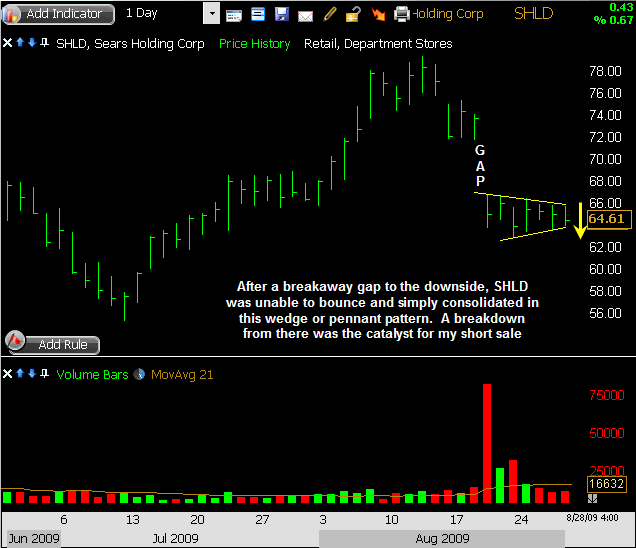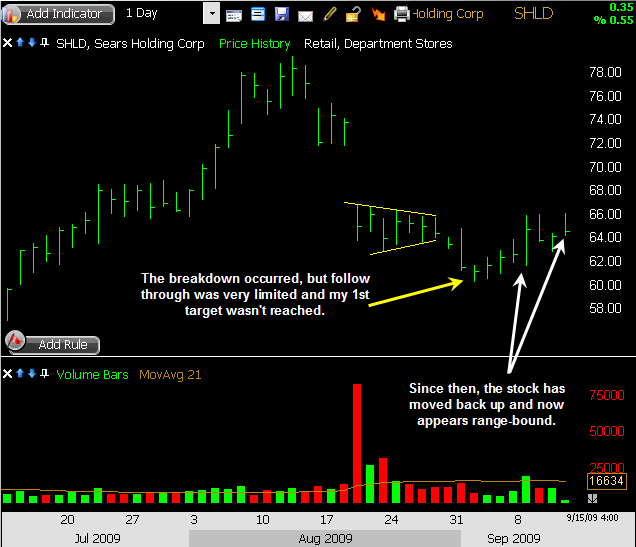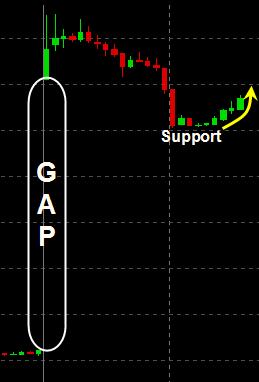 All Entries Tagged With: "Stop Loss"
All Entries Tagged With: "Stop Loss"
Premature Evacuation from Trades
May 23, 2011 at 10:10 am
 All of us have the occasional urge to jump ship early from a trade, but when is it the right time and how should that be done?
All of us have the occasional urge to jump ship early from a trade, but when is it the right time and how should that be done?
Let’s take a look at a conversation I recently had with a trader I was helping…
Hey Jeff,
I’m long ***, as it just looked like a nice setup. I went long 4 days ago, but it is behaving horribly. Currently I don’t see any pattern and would not make this trade now, but it is only halfway to my stop loss. I am unsure what to do. How do you approach trades you aren’t convinced of anymore, but have not been stopped out of?
Also, one of the mantras I read often is “cut losses short, let winners ride.” I am wondering how to interpret this “cut losses?” I find myself thinking, “I am not convinced in this trade anymore, but maybe it will turn around, it’s just half a position left to lose.” When my analysis of the situation shifts, and I wouldn’t take this trade anymore as of today, do I abandon my original plan and exit immediately or should I stay with the trade?
C.
==
Here’s what I told him…
C,
Let me start off by addressing the “cut losses short” question. I don’t have all the answers, but I can tell you that for me, cutting losses means having an exit plan on the downside with defined risks. We will all be wrong at times, but staying wrong is different – don’t stay wrong! Limit your losses so that they can be overcome with reasonable winning trades. Don’t dig a hole so deep you need a miracle to get out – that’s cutting your losses short.
Now let’s discuss early exits on trades like this where your conviction level has changed…
Occasionally you’ll find trades like this which don’t completely fail (stop you out), yet don’t work either (move to your targets). Instead, they just begin to stagnate and enter into a trading range where your funds are tied up. It can be a bit frustrating, simply because you’re left in limbo, wondering if the trade is in the process of failing or working. Each new red or green bar feels like the start of something meaningful, but they’re followed by the opposing color and you soon realize that price is simply showing indecision.
A key consideration to make when this happens is whether the character of the stock has changed. Stated otherwise, do you have a good reason to now lack conviction, or is it merely a mood shift for you?
A slow-moving trade is far different than one which may have just experienced an important technical event…
- Just because a trade isn’t developing quite as quickly as you would have wanted doesn’t mean it’s destined for failure.
- The stock may be building a new pattern which you simply haven’t identified yet.
- When I find myself in a trade which is starting to bore me, I know I’m overanalyzing when I start looking for signals which aren’t there.
- If I’m positioned in accordance with the overall market (ie: long in a market uptrend), and if my trading capacity isn’t restricted because of this position (I don’t need to free up capital), then what I need to do is stay with the trade until a technical reason prompts an exit. I likely need to stay patient, as this is still a trade which can pay me.
On the other hand, there are times when a premature exit may be warranted…
- When the stock has just seen a change in character as measured by a technical event (high-volume reversal, for example), an adjustment may be called for.
- If your trading funds are limited and you’d rather shift into a better idea, then you might consider closing out the trade in favor of another with more promise.
- When you find yourself positioned in opposition to the prevailing market trend (ie: long in a market downtrend), then you have grounds to at least lighten up. That can be done either by reducing your position while maintaining your original stop & target parameters for the trade, or by tightening both your risk and objective.
What else could help C. in this situation?
Trade Like a Bandit!
Jeff White
Producer of The Bandit Broadcast
Are you following me on Twitter yet?
Options vs. Common Stock
November 17, 2010 at 11:13 am
 Traders face many hard decisions every day…buy or sell, add or lighten, stand aside or get involved. Among them is the choice between trading options or common stock.
Traders face many hard decisions every day…buy or sell, add or lighten, stand aside or get involved. Among them is the choice between trading options or common stock.
There are no doubt benefits and shortcomings of both choices, as everything literally is a trade-off.
Common is usually much more liquid, it can be traded in the after hours or premarket, and it’s by definition 100% exposure to the company. However, it is more capital-intensive since it’s not a leveraged position, which means less room for other positions in an account. Common alone is also going to carry with it greater dollar risk, as a major headline can bring tremendous gap potential.
Options are leveraged, they offer lots of versatility and possibilities (speculation, hedging, income, etc.), and they are less capital-intensive. However, liquidity is often inferior compared to common, they can’t be traded as many hours of the day as stock, and they offer only fractional exposure to the underlying stock.
The Case for Options
Options can be an excellent vehicle for trading, provided the situation is well-suited to them. The biggest 3 considerations for options are (1) the time expectation for the trade, (2) the liquidity of the options being traded, and (3) the risk involved in the trade. Let’s break those down.
Timeframe
First things first… The time you expect to be in the play is important because options will carry a bid/ask spread often times up to maybe .10-15 cents. For a stock that’s not a huge deal, but for an option which might only be trading at say $2 or lower, that’s a big percentage if you pay the spread both ways (market order getting in & out). So if you’re looking at being in a trade for at least a couple of days, that’s usually much better for an options trade than if you’re just looking to scalp it over the next half hour.
Liquidity
Second, there are quite a few stocks which have high trading volume, but for whatever reason their options are just not heavily traded. For any trade I take, whether a stock or an option, I want to feel confident there will be buyers when I go to sell, and sellers when I go to buy. Sufficient liquidity is a requirement for any trade, whether in options or common. So taking a look at the open interest, the volume, and the bid/ask spread is important in gauging the liquidity of the options. When in doubt, take a look at the highly liquid options like QQQQ, SPY, or mega-cap stocks like MSFT or INTC. That will help you get a feel for how tight the market is in the options you’re considering. You don’t ever want to be the ‘big player’ in any contract.
Risk
Third, limited risk is an advantage which options carry, such as buying put options vs. being short stock. Risk is defined with the puts, and theoretically unlimited with the short stock. Options are a great choice in particular when the stock has the potential to gap big, whether due to news coming out or simply based upon recent price history of the stock. Always consider the risk involved when weighing options vs. common, as that’s an important element of the decision-making process.
Finally, here are a few occasions to consider options rather than the common shares:
1. In front of big news (earnings, conference calls, or anything else scheduled).
2. When limited on capital (the leverage of options helps offset a limited amount of funds).
3. When the stock moves are too shaky to sit through (when a really wide stop is necessary).
4. Trade timeframe is between a couple days and a few weeks.
** If you’ve got something else to add, please share it in the comments.
Trade Like a Bandit!
Jeff White
Producer of The Bandit Broadcast
Are you following me on Twitter yet?
5 Rookie Trader Mistakes & How to Avoid Them
October 4, 2010 at 8:50 am
 In trading, as in life, lessons can be learned out of inspiration or desperation. It’s hard to say which is better, but I know that regret is quite a teacher.
In trading, as in life, lessons can be learned out of inspiration or desperation. It’s hard to say which is better, but I know that regret is quite a teacher.
For example, I’m in the process of buying a house right now, which will be the second for my wife and me. Eight years ago, I made several mistakes as a first-time buyer, some of which I’ve wished I could go back and change. Experience educates each of us, fortunately, and needless to say this time around (I think) I’m doing it right.
A lack of experience is responsible for many mistakes newer traders make as well. Those errors not only prove costly the first time around, but they can also ingrain some bad habits if not corrected quickly.
Over the years, I’ve been fortunate to work with hundreds of traders around the globe, of all trading styles and timeframes. And yet as diverse as these traders seem to be, a handful of common issues continue to surface. Coincidence? No. Just human nature, which the market preys upon.
So, to help you stay on the right path with your trading, let’s take a look at 5 common mistakes rookie (or struggling) traders make, and how to avoid them.
1. Adding to Losing Positions. This is a biggie, and it addresses perhaps the most common lapses in judgment among traders of all experience levels. Gartman says to “do more of what is working, and less of what isn’t working.” By definition, a losing position is not working. And unless you originally planned to scale into the trade, adding to a loss is a big no-no. Take note of your P&L, and if you’re wrong, avoid throwing good money after bad.
2. Forcing Trades Out of Boredom. Boredom is one of the biggest enemies of today’s trader, because it leads to so many bad decisions (like overtrading). Transaction costs are so low and it’s so easy to place trades that one can easily forget just how costly boredom trades can become. So if you’ve done your homework and come up with very little, place no pressure on yourself to be active. There are times where sitting tight is exactly what you should be doing, so have the courage and discipline to do nothing when that’s the case.
3. Switching Strategies By the Day. I’m all for trading with multiple strategies, and as your experience increases, your trading toolbelt will begin to fill. However, each of us during times of struggle has encountered the losing streak. That’s perhaps the biggest cause for traders to throw the proverbial spaghetti at a wall to see what sticks. While experimenting can yield some clarity, doing it in either the wrong fashion or too frequently can prove counterproductive. Get some trader training, put some strategies to work across multiple timeframes, and give them enough time to prove their effectiveness. Trying something for a day, losing money with it, and shifting quickly to something else isn’t responsible, so avoid that limited mindset.
4. Putting Everything on the Line for one ‘Idea’ Trade. I was once warned by a more-experienced trader, “don’t get any ideas!” He was right. A longer-term thesis takes time to play out, so leave that to the fundamentalists who don’t mind tying up their capital for months on end – for better or for worse. Stick with what the price action is telling you, and determine the best opportunities to get on board for the next move. Ideas are only useful when they relate to technical discoveries, so don’t bank on guessing right for one big recovery play – it may instead prove to be the final nail in the coffin.
5. Hoping a Stock Will Recover. Each of us has been trapped by a bad trade, and we’ve wondered if sitting motionless and simply hoping to be let out of the trap is the best solution. Marty Schwartz, of Pit Bull fame, mentioned how as a soldier, he was trained to do something when under attack…either fight back or retreat, but don’t just sit there. Hope truly is a 4-letter word in the trading realm, and relying solely on hope will provide plenty of damage to your trading account. Stops are available for good reason. Game plans offer if/then scenarios to follow under the gun so that big decisions need not be made in times of stress or volatility.
Avoid making these mistakes, and your money will be much harder for the pro’s to take.
Trade Like a Bandit!
Jeff White
Producer of The Bandit Broadcast
Are you following me on Twitter yet?
One Intraday Setup That’s Working
September 28, 2010 at 9:38 am
In a world dominated by algo’s and machines, the astute trader can still turn a profit. It’s true, despite what many losing traders might tell you.
It takes adaptation, some ingenuity, imagination, and of course, thinking outside the box. For the creative trader though, new patterns will emerge from which profitable trades can be made.
So today, I wanted to point out to you one such example. I won’t name the stock, because it doesn’t matter, but here’s the chart from the opening 50 minutes or so:
As you can see, this stock gapped higher, ran a little more initially, and then began to roll over. The selling intensified as new lows were made on the session, and the gap began to fill before a brief period of rest set in. But that wasn’t the end of the story. Conventional day trading wisdom says this gap keeps getting filled, but only if another new low is made with a break of that intraday support.
Lately I’ve noticed this kind of setup – and you can reverse it with a downside gap if you’d like – offering some good plays. I had one finger on the trigger to short sell this one upon a break of that support, but it held just above the whole number. As the stock started to catch a bid, I went long with a very tight stop – only $0.06 from my long entry. And only 10 minutes later I was flipping out my shares for a quick $0.50 winner.
** For those wondering, that’s a reward-to-risk ratio of better than 8:1.
This setup offers two things I really like…
First, it offers very minimal, defined risk. If support (or resistance in the case of a morning gap down) gives way, I’m out quick for a small loss.
Second, it offers a great pivot area where emotion is building. The battle that took place at support was really something, and once one side began to win out (in this case the buyers), it sparked a quick move away from that level.
So, keep an eye out for this setup – it’s been a great one to trade. Gaps which only partially fill before hesitating at a level just might offer you a quick, profitable reversal play like this one.
Trade Like a Bandit!
Jeff White
Producer of The Bandit Broadcast
Are you following me on Twitter yet?
15 Questions & Answers
August 24, 2010 at 10:48 am
My recent live interview with Charles Kirk generated quite a few questions. A number of them we were able to address during the chat, but many went unanswered.
If you were in attendance and didn’t get your question answered, look for it below. But even if you weren’t there, hopefully you’ll find this useful to observe. I’m also happy to answer questions via the comments section below, so feel free to post yours there!
Here are 15 unanswered questions from the session:
1. Kevin: Jeff, what timeframe do you normally use in your charts, and do you let the bar close before entering a trade?
- Thanks for your question Kevin. I focus on the daily charts for swing trades, and the 3-minute charts for day trades. I don’t wait for the bar to close before entering a trade. That might save me an occasional failed signal, but I feel it will cost me many other trades which work right from the start, so for me it’s worth taking my entries as they signal.
2. Ryan: Do you have any execution techniques that you like to use?
- Hi Ryan! I like to keep things really simple, so I use basic stops for entries and exiting losing trades. That way, once a level has been crossed, a market order is generated immediately and I’m in (or out of) the trade. I’ve tried to get cute in the past with more complicated orders or execution techniques, but in the end it made me no more money and often cost me opportunity (buying breakouts with a limit order, for example, as the stock never looks back). When I’m booking profits, I’ll use limit orders at my targets and let the stock come up and hit me, but that’s the only time I utilize them.
3. Moe: How can you scan the market for setups or make trades when the market is so volatile and so driven by daily events and emotions?
- Yes Moe, it truly is a news-driven environment right now, and it might be that way for a while. I think the key is recognizing that I’m not trying to get in front of any news or predict what news may come along. Instead, I’m looking to put capital at risk when there’s an expected reward, and in order to do that I need to be hitting the charts regularly. Training your eye to do that will always leave you with opportunity, whereas waiting for emotions to settle could leave you sidelined possibly forever. Remember, that emotion and volatility brings with it opportunity. On the flip side, a trendless market with nothing but uncertainty brings with it very little opportunity. Keep looking for trades, and keep your capital moving.
4. Guest: What sectors are you finding most of your trades these days?
- Hello and thanks for your question. In terms of swing trades, I’ve traded many sectors and there really has been no consistency there to speak of. When the right patterns emerge, I take the trades. In terms of day trading though, I’ve focused frequently on the ags, financials, and energy names quite a bit in recent weeks, as they’ve been in play regularly.
5. Jon: Isn’t the general rule of thumb that in a correlation study, most of the correlation comes from selection, then overall market, so what we are looking for in trading is the small fraction which lead the pack on a given day which will then beat just trading the index ETF’s?
- Hi Jon, the recent discussion of being in a highly-correlated market (to the S&P 500, for example) carries with it some weight, yes. And I do agree that what we’re after is to locate leaders and trade them instead of the ETF’s. Keep in mind though that there will always be outliers which exhibit extreme strength or weakness, and those carry with them some real potential for good trades. So, seek out momentum whenever possible, and you should find far better bang for your buck vs. the ETF’s.
6. Sam: Do you ever trade options?
- Hey Sam, I do trade them on occasion. In longer-term accounts, I’ll short puts to establish long positions, then sell calls to collect premium. I don’t do a lot though in terms of directional trading with options. Occasionally when a stock looks to be very high risk, such as BP recently, I’d rather hold options overnight than common, simply to have defined, limited risk. The rest of the time, I’d rather have the shares for the greater liquidity, less slippage, and more flexibility to trade extended hours or pre-market (if necessary).
7. Tom: Do you hold stocks into their earnings report or do you only trade following the report?
- Hi Tom, actually I never want to hold a stock into an earnings announcement. Being a technical trader, it’s important for me that I can use the price action to determine both my entries and exits. That’s technical. When it comes to an earnings announcement, we’re talking about a major fundamental event, and since those usually happen outside market hours, I can’t control my risk. The stock is so likely to gap big after that news that I might have no shot at closing the trade at my planned exit. The excitement of potential ‘free money’ lures many traders into acting on their hunch, but it’s simply a coin toss and I am not about that with my trading. So, I want to stay responsible and only take trades where I expect to be able to manage my risk appropriately.
8. Frenchy: What is your favorite ETF you like to trade?
- Hi Frenchy. When it comes to the main index ETF’s, I like the usual SPY, QQQQ, and IWM. Typically I’ll avoid DIA since it’s only 30 stocks, and that can complicate matters more. In terms of leveraged ETF’s, I’ll go with SSO/SDS, QLD/QID, and TWM/UWM. Those are double exposure, and while there are some triple exposure ETF’s out there, I find the 2x levered funds are enough to provide nice moves.
9. Leon: Do you believe a high volume move to the downside can be a reversal signal?
- Hello Leon, that’s a good question. The short answer is yes, but it depends on how it happens. A stock which has been in a parabolic uptrend will sometimes signal exhaustion in this manner, reversing to the downside on heavy volume. Often, that’s followed by additional weakness. However, a stock that’s range-bound which sees a high-volume decline on a given day may see no downside follow through. So it can happen, but I’d be careful not to put a blanket statement across all high-volume selloffs that they’re reversal signals.
10. Jon: Do you feel price follows volume, or volume follows price?
- Hi Jon, this is a real chicken-and-the-egg topic, and there are cases of both. For example, consider a stock in a pattern like a bull flag. Price is consolidating, but one day edges toward upper resistance on heavy volume. That will many times signal an impending breakout, so volume in that case tends to lead the way. In other cases, price begins to gain momentum, and as the stock gets more attention, the volume naturally increases (following the move in price). See CAGC in recent weeks for an example of this. So it can happen either way. Nonetheless, I care the most about price, so if I’m seeing volume kick in ahead of a breakout, for example, I’ll still want to see price confirm that before I look to make an entry. That keeps me sidelined until I believe a real move is starting. Just remember, price is of utmost importance. If you’re on the wrong side of a move, it doesn’t matter if the volume is heavy or not, it’s still going to hurt!
11. Ryan: Do you have any interesting research projects in the works?
- Hi Ryan, actually I just recently completed a huge project with the creation of the Advanced Trading Course over at TheStockBandit University. That was a major project and I put everything I know into that course, so I don’t plan to do any other big projects for a while.
12. Layne: What indicators do you like to use? Certain ones in certain markets?
- That’s a great question Layne. I should say right up front I don’t rely on any indicators across the board, and actually utilize them rather infrequently. However, there are times when they can help in the trading process, so I’ll put them on the chart when it’s appropriate. A moving average, for example, is really only helpful in a trending market. I just put out a post explaining how and when to use moving averages. I will sometimes add ATR to my chart to see just how much (or how little) movement there’s been lately, and that’s another one which has been helpful for me. If anything, the ATR value lets me know when there’s just not enough movement to offer real potential relative to the risk I’d be taking.
13. Jake: What are the setups that you look for on the chart before buying and selling?
- Hi Jake, first I’m going to look for the presence of a trend. If there isn’t one, I’ll take a completely different approach in terms of what types of patterns I’ll look for. If there is a trend, then I’ll be watching for continuation setups like flag patterns, pennant patterns, and triangle patterns. And along with the price patterns, it’s important that the volume activity is confirming the price action, so I monitor that closely as well. Taking note of the rhythm of a trend is another key element, as it helps me gauge whether I should focus more on breakout patterns or utilizing pullbacks to get on board. There are a ton of ways to skin the market cat, but I’ve found it most effective to adjust to the environment you’re in rather than forcing one particular style at all times.
14. Ryan: Do you see the growing awareness and popularity of ‘technical analysis’ translating into an easier market to trade in the future, or a more unpredictable one as more retail money uses the same methods?
- Hello Ryan, another excellent question. Technical Analysis 101 has certainly become more embraced by retail traders than it was even a few years ago, but my response to that is somewhat complicated. First of all, I don’t think there’s a uniform usage of technical analysis methods across retail traders. Take 10 traders and ask them to define a particular pattern, or ask when they should use a particular indicator, and you’re likely to get a variety of answers. So that’s one issue I think that keeps everyone from seeing the exact same patterns or acting on them at the exact same time. Another issue is a bit more vague, which is the program trading we’ve seen such a growing amount of in recent years. Computer algorithms are likely preventing some patterns from fully maturing, or the institutional money heavily fades a breakout, causing many retail traders with tight stops to dump shares, only to see the stock head right back up. So it can be pretty tricky out there, and for those reasons, I do not think the rise of Technical Analysis has resulted in an easier market to trade. Bottom line is, ‘they’ will never make it easy. You and I have to keep paying attention to what’s working and what isn’t, and do more of that which is working!
15. Guest: Have there been any patterns you’re finding that are working well in this environment?
- Thanks for your question, and yes there are. I’ve focused more on trading the rising and falling wedges, as well as the “tilted” trend line breaks (like ascending or descending trend line breaks) for swing trading. For day trading, I’ve looked more for those exhaustion moves where news has caused an overreaction and the stock needs to come back in, so those are the ones I’d say have been most profitable to me in recent months. I also detail the most profitable one in the Advanced Trading Course. The key is to remember that what’s working well right now will eventually morph into something else, so we have to stay on our toes and be willing (and able) to adjust when conditions deem it necessary.
Trade Like a Bandit!
Jeff White
Producer of The Bandit Broadcast
Are you following me on Twitter yet?
Making it Back
June 29, 2010 at 7:01 am
Anytime the market makes as big and consistent of a run as it did from March 2009 to the April peak, there’s a growing confidence that invites new money to the game. Those who were completely spooked in early 2009 saw an impressive rebound, not only in prices but in their willingness to participate.
Of course, the longer in the tooth a rally becomes, the closer the end of it naturally gets. That’s unfortunate for some, but it’s simply the nature of risk in the market. After all, those who step out on a limb first will stand to make the most if they’re proven right, while others who wait for more of a sure thing may be among the last to the party right before it ends.
It’s natural for someone who buys at or near the peak to quickly find themselves underwater, and at this point just a short time removed from the April highs, there are no doubt many folks who were late to the party now feeling serious pain.
That feeling of panic has set in for them, and in most cases, there’s no exit plan. The failure to designate a safety net prevents level-headed execution of a game plan, so now they’re forced to think fast in the heat of the moment, sparking a slew of potential mistakes. Making it back now becomes the primary goal, as if there’s something magical about getting out unscathed. Nevermind the fact that the entry was made in hopes of turning an actual profit.
Exaggerating Errors
Traders face this dilemma on every timeframe when in a bad trade. With a negative P&L on the day, week, month, or year, the focus turns from sticking with a strategy to doing anything that might get them out of the hole – and fast.
Along with this mindset comes an urgency factor which may not have been present before – uh oh! The sudden recognition that they might be perceived as having been wrong strikes fear in their hearts and now the race is on to erase the losses.
I’ve been there plenty of times, and it’s no fun. But over the years, I’ve found several ways to reduce the impact of my errors. Here are a few things I try to do when I find myself underwater:
- Slow down. Often times the desire to just get into anything that might be moving means it’s also easy to overtrade. Spinning my wheels won’t help my P&L, and it sure won’t help my objectivity.
- Get selective. Rather than jumping quickly on anything that comes along, I’m going to be much more effective if I wait for the cream of the crop to surface. Waiting for the best risk/reward opportunities to arrive means passing up many other plays along the way, and returning to holding a high standard for where my capital is allocated.
- Trust your method. Some stretches of trading are better than others, absolutely. At times it’s extremely frustrating, while other times it feels almost easy. So there will be ups and downs, but over time my method has served me very well. When I find myself with the wrong color P&L, I remind myself that I’ll eventually get my groove back, so long as I don’t stray far from my style. As they say here in Texas, “dance with the one that brung ya.”
Translation for Timeframes
On a day trading timeframe, it can be tough to take a few hits early in the session. Your confidence gets quickly shaken, and you wonder whether it’s just a tough start from which you can recover, or if instead it just isn’t your day. The key is to avoid emotion-based decisions, which will lower your standard for trades and shift your attention to the money rather than the price action. Never do you want your losses to cause you to force trades, so if that’s your primary motivator, get away and return another day. If instead there are still ample opportunities for good trades, patiently wait for the best risk/reward setups and then make the most of them.
For a swing trading timeframe, streaks will happen where at times it seems you’re on the wrong side in every trade you place. Making it back will take a little longer, but it can be done if you’re methodical about it. Cut down your size immediately while you wait to find your groove, as that will slow the pace of your losses if you continue to time trades poorly. Become selective, because confusion can set in quickly if you aren’t following a clear strategy with a known objective. Patience will be crucial, but it can pay quite well, too.
Finding yourself down in a hole is no fun, but it’s a reality of trading that each of us will face from time to time. So take a long-term view with your trading career, even if your timeframe for each trade is quite short-term. Doing so will keep you level-headed when it’s the hardest, and it’ll make you tougher and better as you find your way back on the right side – and you will!
Trade Like a Bandit!
Jeff White
Swing Trading & Day Trading Service
www.TheStockBandit.com
Are you following me on Twitter yet?
Implementing the Time Stop
September 15, 2009 at 10:03 am
Staying patient with a position can sometimes pay off nicely. After all, not every trade works out exactly when we want it to. It might require a little more time than we originally expected before we see that P&L turn the shade of green we were looking for, and it’s sure nice when that happens.
But there is a flip side to the coin.
Sometimes you can be overly patient with a trade, giving it more and more time (dare I say too much?), just waiting for it to make its move. And I’m not referring to letting it move farther and farther against you – you know better than that!
I’m talking about the trade that simply goes nowhere.
Fortunately, there is a solution to the flatlining trade, which is to implement a time-based stop. This is essentially a countdown placed on the trade, that if nothing happens by a certain time, then either an adjustment is made to stop & target levels, or the trade is simply closed out. You know – so you can move on with your life!
After all, why tie up capital in a position which isn’t performing as expected? Kicking a stagnant trade to the curb can translate into more money to be put toward another opportunity, plus it enables us as traders to put our attention toward something more worthwhile.
Show Me the Money!
Just this week I faced this dilemma. I was swing trading SHLD on the short side due to the breakdown from a bear pennant pattern (see chart 1 below), but aside from the initial weakness, there was no follow through (see chart 2 below).
I had designated 2 targets for my exit, and of course 1 stop loss in case the stock reversed and went back above resistance, but none of those levels were reached. The stock refused to go down far enough for me to start booking profits (according to my trading plan), and yet it wasn’t bouncing enough to stop me out either.
Chart 1:
 StockFinder Chart courtesy of Worden
StockFinder Chart courtesy of Worden
Chart 2:
 StockFinder Chart courtesy of Worden
StockFinder Chart courtesy of Worden
Although SHLD was certainly underperforming the market, and I felt confident if market weakness ever arrived that SHLD would crack pretty good, that never happened. The stock simply formed a trading range, and I began to realize it was essentially a stagnant trade.
Time to Move On
Over the weekend, I decided I’d give the stock through Monday before making any moves, and so when it remained in its range, I tightened my stop heading into Tuesday, and today as the stock reached my adjusted stop I closed the position for a minor loss.
I know what some of you are thinking… Why give up on what might eventually develop into a good trade?
Don’t think of this as surrendering or giving up on a trade, because I know that can be difficult for traders who don’t mind being patient. Rather, consider it your responsibility as a trader to keep your capital working for you in the best manner possible.
That means putting it at risk when there’s a good possibility of profiting, and it means protecting it from risk when that potential isn’t present.
The longer we’re in a position as traders, the more we become exposed to company-specific, unplanned news…a surprise, if you will. Leaving a position at risk indefinitely raises the likelihood that news will eventually push the trade one way or the other. The problem with that is that a trade initiated from a technical standpoint should not evolve into a trade which is hopeful for news to make it move. We want real selling or buying to be the deciding factor, and when that turns stagnant then the basis for the trade is negated.
So as you work through your position sheets this week, consider whether some of those stocks are merely resting or if instead they’ve completely lost momentum and are now simply range-bound.
Do your best to determine if a little more patience is needed, or if instead a little less patience is warranted. Time is money, especially for a trader. It might be time to put that trade on the clock and set a deadline. A far better trade just might be waiting for you.
Thanks for stopping by and I’ll see you here soon with more. Until then…
Trade Like a Bandit!
Jeff White
Are you following me on Twitter yet?






